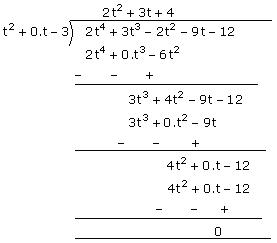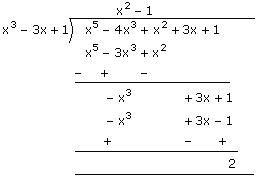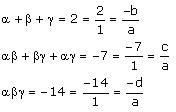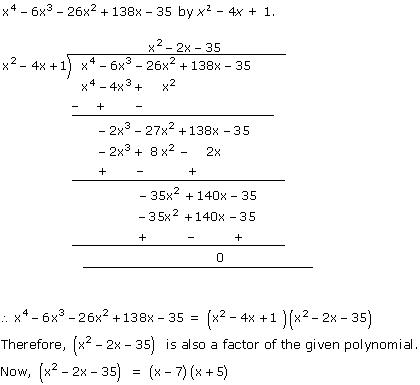Chapter 2 - Polynomials
Excercise 2.1
Solution 1
(i) The graph of P(x) does not cut the x-axis at all . So, the number of zeroes is 0.
(ii) The graph of P(x) intersects the x-axis at only 1 point.
So, the number of zeroes is 1.
(iii) The graph of P(x) intersects the x-axis at 3 points.
So, the number of zeroes is 3.
(iv) The graph of P(x) intersects the x-axis at 2 points.
So, the number of zeroes is 2.
(v) The graph of P(x) intersects the x-axis at 4 points.
So, the number of zeroes is 4.
(vi) The graph of P(x) intersects the x-axis at 3 points.
So, the number of zeroes is 3.
At all these points where the graph intersects x axis the value of the polynomial y = p(x) will be zero.
(ii) The graph of P(x) intersects the x-axis at only 1 point.
So, the number of zeroes is 1.
(iii) The graph of P(x) intersects the x-axis at 3 points.
So, the number of zeroes is 3.
(iv) The graph of P(x) intersects the x-axis at 2 points.
So, the number of zeroes is 2.
(v) The graph of P(x) intersects the x-axis at 4 points.
So, the number of zeroes is 4.
(vi) The graph of P(x) intersects the x-axis at 3 points.
So, the number of zeroes is 3.
At all these points where the graph intersects x axis the value of the polynomial y = p(x) will be zero.
Excercise 2.2
Solution 1

So, the zeroes of x² - 2x - 8 are 4 and -2.






Solution 2
(i) Let the required polynomial be ax² + bx + c, and let its zeroes  and
and 
 and
and 
 If a = 4k, then b = -k, c = -4k Therefore, the quadratic polynomial is k(4 x 2 - x - 4), where k is a real number .
If a = 4k, then b = -k, c = -4k Therefore, the quadratic polynomial is k(4 x 2 - x - 4), where k is a real number .(ii) Let the polynomial be ax² + bx + c, and let its zeroes be
 and
and 
 (iii) Let the polynomial be ax² + bx + c, and let its zeroes be
(iii) Let the polynomial be ax² + bx + c, and let its zeroes be  and
and 
 (iv) Let the polynomial be ax² + bx + c, and let its zeroes be
(iv) Let the polynomial be ax² + bx + c, and let its zeroes be  and
and 
 Therefore, the quadratic polynomial is k(x² - x + 1),where k is a real number .
Therefore, the quadratic polynomial is k(x² - x + 1),where k is a real number .(v) Let the polynomial be ax² + bx + c, and its zeroes be
 and
and 
 Therefore, the quadratic polynomial is k(4x² + x + 1),where k is a real number .
Therefore, the quadratic polynomial is k(4x² + x + 1),where k is a real number .(vi) Let the polynomial be ax² + bx + c.
 Therefore, the quadratic polynomial is k(x² - 4x + 1),where k is a real number .
Therefore, the quadratic polynomial is k(x² - 4x + 1),where k is a real number .Polynomials Page/Excercise 2.3
Solution 1

Quotient = x - 3
Remainder = 7x - 9

Quotient = x2 + x - 3
Remainder = 8

Quotient = -x2 - 2
Remainder = -5x + 10
After performing division, one can check his/her answer obtained by the division algorithm which is as below:
Dividend = Divisor x Quotient + Remainder
Also, remember that the quotient obtained is a polynomial only.
Solution 2
The polynomial 2t4 + 3t3 - 2t2 - 9t - 12 can be divided by the polynomial t2 - 3 = t2 + 0.t - 3 as follows:

Since the remainder is 0, t² - 3 is a factor of 2t4 + 3t3 - 2t2 - 9t - 12 .
(ii) The polynomial 3x4 + 5x3 - 7x2 + 2x + 2 can be divided by the polynomial x2 + 3x + 1 as follows:
Since the remainder is 0, x² + 3x + 1 is a factor of 3x4 + 5x3 - 7x2 + 2x + 2
(iii) The polynomial x5 - 4x3 + x2 + 3x + 1 can be divided by the polynomial x3 - 3x + 1 as follows:

Since the remainder is not equal to 0, x3 - 3x + 1 is not a factor of x5 - 4x3 + x2 + 3x + 1.
Solution 3

Since the remainder is 0, t² - 3 is a factor of 2t4 + 3t3 - 2t2 - 9t - 12 .
(ii) The polynomial 3x4 + 5x3 - 7x2 + 2x + 2 can be divided by the polynomial x2 + 3x + 1 as follows:
Since the remainder is 0, x² + 3x + 1 is a factor of 3x4 + 5x3 - 7x2 + 2x + 2
(iii) The polynomial x5 - 4x3 + x2 + 3x + 1 can be divided by the polynomial x3 - 3x + 1 as follows:

Since the remainder is not equal to 0, x3 - 3x + 1 is not a factor of x5 - 4x3 + x2 + 3x + 1.
Solution 3
Let p(x) = 3x4 + 6x3 - 2x2 - 10x -5

Now, x² + 2x + 1 = (x + 1)2
So, the two zeroes of x² + 2x + 1 are -1 and -1.

Solution 4

Now, x² + 2x + 1 = (x + 1)2
So, the two zeroes of x² + 2x + 1 are -1 and -1.
Solution 4
Divided, p(x) = x3 - 3x2 + x + 2
Quotient = (x - 2)
Remainder = (-2x + 4)
Let g(x) be the divisor.
According to the division algorithm,
Dividend = Divisor x Quotient + Remainder

When a polynomial is divided by any other non-zero polynomial, then it satisfies the division algorithm which is as below:
Dividend = Divisor x Quotient + Remainder
Divisor x Quotient = Dividend - Remainder
So, from this relation, the divisor can be obtained by dividing the result of (Dividend - Remainder) by the quotient.
Quotient = (x - 2)
Remainder = (-2x + 4)
Let g(x) be the divisor.
According to the division algorithm,
Dividend = Divisor x Quotient + Remainder

When a polynomial is divided by any other non-zero polynomial, then it satisfies the division algorithm which is as below:
Dividend = Divisor x Quotient + Remainder
Divisor x Quotient = Dividend - Remainder
So, from this relation, the divisor can be obtained by dividing the result of (Dividend - Remainder) by the quotient.
Solution 5
According to the division algorithm, if p(x) and g(x) are two polynomials with g(x) 0, then we can find polynomials q(x) and r(x) such that
0, then we can find polynomials q(x) and r(x) such that
According to the division algorithm, if p(x) and g(x) are two polynomials with g(x)
 0, then we can find polynomials q(x) and r(x) such that
0, then we can find polynomials q(x) and r(x) such that
p(x) = g(x) x q(x) + r(x), where r(x) = 0 or degree of r(x) < degree of g(x).
(i) Degree of quotient will be equal to degree of dividend when divisor is constant.
Let us consider the division of 18x2 + 3x + 9 by 3.
Here, p(x) = 18x2 + 3x + 9 and g(x) = 3
q(x) = 6x2 + x + 3 and r(x) = 0
Here, degree of p(x) and q(x) is the same which is 2.
Checking:
p(x) = g(x) x q(x) + r(x)

Thus, the division algorithm is satisfied.
(ii) Let us consider the division of 2x4 + 2x by 2x3,
Here, p(x) = 2x4 + 2x and g(x) = 2x3
q(x) = x and r(x) = 2x
Clearly, the degree of q(x) and r(x) is the same which is 1.
Checking,
p(x) = g(x) x q(x) + r(x)
2x4 + 2x = (2x3 ) x x + 2x
2x4 + 2x = 2x4 + 2x
Thus, the division algorithm is satisfied.
(iii) Degree of remainder will be 0 when remainder obtained on division is a constant.
Let us consider the division of 10x3 + 3 by 5x2.
Here, p(x) = 10x3 + 3 and g(x) = 5x2
q(x) = 2x and r(x) = 3
Clearly, the degree of r(x) is 0.
Checking:
p(x) = g(x) x q(x) + r(x)
10x3 + 3 = (5x2 ) x 2x + 3
10x3 + 3 = 10x3 + 3
Thus, the division algorithm is satisfied.
Concept insight: In order to answer such type of questions, one should remember the division algorithm. Also, remember the condition on the remainder polynomial r(x). The polynomial r(x) is either 0 or its degree is strictly less than g(x). The answer may not be unique in all the cases because there can be multiple polynomials which satisfies the given conditions.
(i) Degree of quotient will be equal to degree of dividend when divisor is constant.
Let us consider the division of 18x2 + 3x + 9 by 3.
Here, p(x) = 18x2 + 3x + 9 and g(x) = 3
q(x) = 6x2 + x + 3 and r(x) = 0
Here, degree of p(x) and q(x) is the same which is 2.
Checking:
p(x) = g(x) x q(x) + r(x)

Thus, the division algorithm is satisfied.
(ii) Let us consider the division of 2x4 + 2x by 2x3,
Here, p(x) = 2x4 + 2x and g(x) = 2x3
q(x) = x and r(x) = 2x
Clearly, the degree of q(x) and r(x) is the same which is 1.
Checking,
p(x) = g(x) x q(x) + r(x)
2x4 + 2x = (2x3 ) x x + 2x
2x4 + 2x = 2x4 + 2x
Thus, the division algorithm is satisfied.
(iii) Degree of remainder will be 0 when remainder obtained on division is a constant.
Let us consider the division of 10x3 + 3 by 5x2.
Here, p(x) = 10x3 + 3 and g(x) = 5x2
q(x) = 2x and r(x) = 3
Clearly, the degree of r(x) is 0.
Checking:
p(x) = g(x) x q(x) + r(x)
10x3 + 3 = (5x2 ) x 2x + 3
10x3 + 3 = 10x3 + 3
Thus, the division algorithm is satisfied.
Concept insight: In order to answer such type of questions, one should remember the division algorithm. Also, remember the condition on the remainder polynomial r(x). The polynomial r(x) is either 0 or its degree is strictly less than g(x). The answer may not be unique in all the cases because there can be multiple polynomials which satisfies the given conditions.
Polynomials Page/Excercise 2.4
Solution 1

On comparing the given polynomial with the polynomial ax3 + bx2 + cx + d, we obtain a = 2, b = 1, c = -5, d = 2

Thus, the relationship between the zeroes and the coefficients is verified.

On comparing the given polynomial with the polynomial ax3 + bx2 + cx + d, we obtain a = 1, b = -4, c = 5, d = -2.

Thus, the relationship between the zeroes and the coefficients is verified.
Concept insight: The zero of a polynomial is that value of the variable which makes the polynomial 0. Remember that there are three relationships between the zeroes of a cubic polynomial and its coefficients which involve the sum of zeroes, product of all zeroes and the product of zeroes taken two at a time.
Solution 2
Let the polynomial be ax3 + bx2 + cx + d and its zeroes be  .
.
According to the given information:

If a = k, then b = -2k, c = -7k, d = 14k
Thus, the required cubic polynomial is k(x3 - 2x2 - 7x + 14), where k is any real number.
The simplest polynomial will be obtained by taking k = 1.
Solution 3
 .
.According to the given information:

If a = k, then b = -2k, c = -7k, d = 14k
Thus, the required cubic polynomial is k(x3 - 2x2 - 7x + 14), where k is any real number.
The simplest polynomial will be obtained by taking k = 1.
Solution 3
Let p(x) = x3 - 3x2 + x + 1
The zeroes of the polynomial p(x) are given as a - b, a, a + b.
Comparing the given polynomial with dx3 + ex2 + fx + g, we can observe that
d = 1, e = -3, f = 1, g = 1

Therefore, the zeroes of p(x) are 1-b, 1, 1+b .

Concept insight: When the polynomial and its zeroes are given then, remember to apply relationships between the zeroes and coefficients .
These relations involve the sum of the zeroes, product of zeroes and the product of zeroes taken two at a time.
The zeroes of the polynomial p(x) are given as a - b, a, a + b.
Comparing the given polynomial with dx3 + ex2 + fx + g, we can observe that
d = 1, e = -3, f = 1, g = 1

Therefore, the zeroes of p(x) are 1-b, 1, 1+b .

Concept insight: When the polynomial and its zeroes are given then, remember to apply relationships between the zeroes and coefficients .
These relations involve the sum of the zeroes, product of zeroes and the product of zeroes taken two at a time.
Solution 4
Therefore, x2 - 4x + 1 is a factor of the given polynomial. For finding the remaining zeroes of the given polynomial, we will carry out the division of

Hence, 7 and -5 are also zeroes of the given polynomial.
Solution 5
By division algorithm,
Dividend = Divisor x Quotient + Remainder
Divisor x Quotient = Dividend - Remainder

It will be perfectly divisible by x2 - 2x + k.

10 - a - 8 x 5 + 25 = 0
10 - a - 40 + 25 = 0
- 5 - a = 0
a = -5
Thus, k = 5 and a = -5.
Concept insight: When a polynomial is divided by any non-zero polynomial, then it satisfies the division algorithm which is as below:
Dividend = Divisor x Quotient + Remainder
Divisor x Quotient = Dividend - Remainder
So, from this relation, it can be said that the result (Dividend - Remainder) will be completely divisible by the divisor.
Dividend = Divisor x Quotient + Remainder
Divisor x Quotient = Dividend - Remainder
It will be perfectly divisible by x2 - 2x + k.

10 - a - 8 x 5 + 25 = 0
10 - a - 40 + 25 = 0
- 5 - a = 0
a = -5
Thus, k = 5 and a = -5.
Concept insight: When a polynomial is divided by any non-zero polynomial, then it satisfies the division algorithm which is as below:
Dividend = Divisor x Quotient + Remainder
Divisor x Quotient = Dividend - Remainder
So, from this relation, it can be said that the result (Dividend - Remainder) will be completely divisible by the divisor.
Comments
Post a Comment